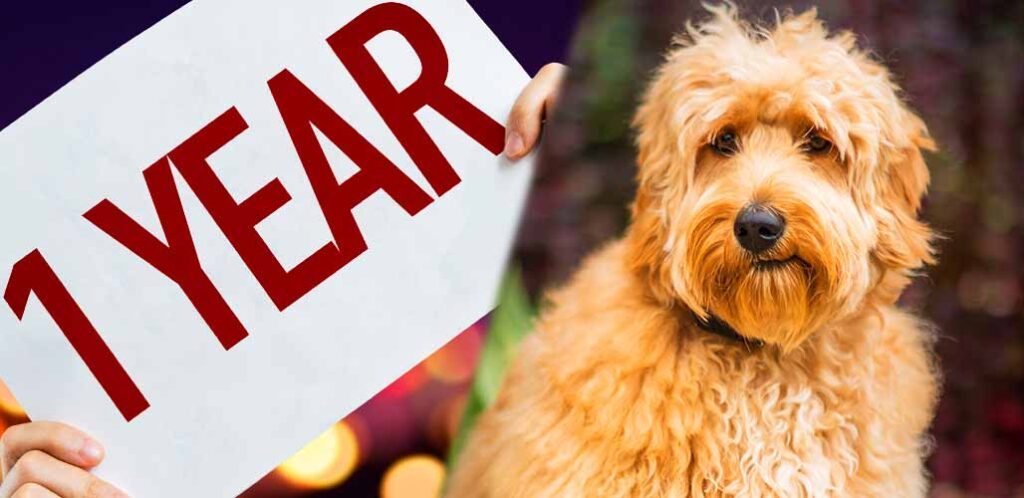
Our complete guide to 1 year old Goldendoodle behavior and development will help you approach their first birthday with confidence. We’ve got answers to all our readers’ frequently asked questions, including ‘when do Goldendoodles stop growing?’, ‘how long does the puppy stage last?’ and ‘what’s the best way to train a 1 year old Goldendoodle?’
- When do Goldendoodles stop growing?
- How much food should a 1 year old Goldendoodle eat?
- 1 year old Goldendoodle behavior
- How to train a 1 year old Goldendoodle
- Caring for your Goldendoodle
- Goldendoodle – 1 year old milestones checklist
Physically, a 1 year old Goldendoodle is nearly fully grown, but emotionally they are still likely to be in the throes of adolescence. There’s still lots to do to make sure they are a well-mannered canine citizen by the time their fully mature.
These young Goldendoodles are full of energy and love playing in the water. Let’s find out more about the needs of doodle dogs around the time of their first birthday.
1 year old Goldendoodle
Since Goldendoodles are crossbreed between a Golden Retriever and a Poodle, there’s lots about them which can’t be predicted with much certainty when they’re born. For example, how big they’ll get, whether their coat will shed, and whether their temperament will be more akin to a Golden Retriever, or a Poodle. But by the time they reach their first birthday, lots of these qualities are likely to have mostly revealed themselves. You can see how physically different two Goldendoodles can turn out by comparing Dude and Bandit in the video above!
When do Goldendoodles stop growing?
This is a surprisingly tricky question to answer! And that’s because the age a dog stops growing is linked to their final weight. The smaller a dog breed, the earlier they tend to finish growing. Golden Retrievers are a large dog breed, weighing 55-75lbs. They usually reach their full adult height by their first birthday, but they could still fill out with further 5lbs or so of muscle. Standard Poodles meanwhile weigh 40-70lbs – large individuals grow at a similar rate to Goldens, but small individuals are fully grown a little earlier, and gain less additional weight after their first birthday.
Furthermore, both Goldens and Standard Poodles are sexually dimorphic – males are significantly bigger than females. Which means that a female Goldendoodle from parents who are petite for their breeds could have finished growing before her first birthday. Whilst a male Goldendoodle puppy from large parents might continue growing until they are 14 or 15 months old.
How much food should a 1 year old Goldendoodle eat?
At a year old, Goldendoodles are ready to switch from their puppy food to an adult alternative. Puppy specific diets are specially formulated to support a period of rapid growth and development, so they’re usually too rich in calories for an adult dog to continue eating. To avoid digestive upsets, it’s a good idea to transition them onto their new food gradually, over the course of about a week. If your puppy has been eating an ‘all life stages’ diet, they can remain on it. But check the portion guidelines on the packaging – it’s likely that they need smaller meals now they’re nearly an adult!

Bear in mind that lots of Goldendoodle puppies are still in the midst of a ‘lanky teenager’ phase as they hit their first birthday. It can be tempting to give them substantial second helpings at dinner time, to try and bulk them up a bit. However, exceeding the recommended portions for their food can also result in digestive upset, and overly rapid weight gain. Usually if you stick to the portion sizes described on the packaging, they will fill out when they finish adolescence. But if you’re worried about your Goldendoodles weight at all, ask their veterinarian’s opinion.
Behavior – how long does the puppy stage last?
Compared to a young puppy, a one year old dog has changed for the better in lots of ways. They no longer bite as much, and they’re less prone to wild over-excitement. But don’t worry if it’s not all plain sailing yet. We’ve already touched on the fact that a 1 year old Goldendoodle is still likely to be in the midst of adolescence. For their wild ancestors, this meant they were finally mature enough to take care of themselves away from their social group – for example going hunting or exploring independently. Modern dogs going through adolescence still usually experience a big increase in confidence and appetite for more independence. This can be frustrating for owners, especially if it translates into behaviors like ignoring the recall whistle!
Your Doodle’s behavior will continue to change and settle over the coming weeks and months, and it’s likely their puppyhood will feel over by the time they’re 18 months old. But they’ll be closer to three years old before their ‘finished’ adult temperament is revealed.
How to train a 1 year old Goldendoodle
So, how do you train a nearly adult Goldendoodle, when it feels like everything you had already taught them is unraveling before your eyes? The answer is to continue using force free, positive reinforcement training – rewarding ‘good’ choices, and limiting their ability to make ‘bad’ choices. This can include using a harness and long line to stop them straying too far from you outdoors, or forming a habit of running up to strangers and unfamiliar dogs. It should also include training games and activities to make focusing on you as rewarding as possible, and provide an outlet for their physical and emotional confidence. Lots of Goldendoodles and their owners enjoy gundog training, agility, and dog sports like dock diving or flyball.
Caring for your Goldendoodle
Now your Goldendoodle is nearly physically mature, at least one thing you can be confident about is that you know what type of coat they’ve got. If their coat is very like a Golden Retriever’s, then it probably needs relatively little maintenance. Regular brushing will help knock out dirt and debris, and sometimes their legs and belly might need washing after a walk.
If they have a Poodle coat, then it’s a very different story. They will need daily brushing right down to the skin, to prevent mats forming. Make sure you’re getting right to the roots, and not just fluffing up the ends while the fur next to the skin gets more and more matted. It’s likely they’ll need clipping every 6 to 8 weeks – don’t be embarrassed to try several groomers in your local area, to find the one who’s the best fit for you.
Spaying and neutering
If you haven’t already considered it, it’s never too late to think about whether your dog ought to be spayed or neutered. Doing this is a personal decision, and with neuter rates hovering around 50%, it’s clear that the right choice is not the same for everyone. Spaying a female dog can prevent pyometra as well as unwanted pregnancies. A 1 year old female Doodle can usually be spayed at any time now, although your vet may prefer to time it for immediately after a season, to reduce the risk of blood loss.
Neutering a male dog should usually wait until they have finished growing. Testosterone produced by the testicles plays an important role in closing the growth plates at the ends of their bones. Early neutering results in dogs growing slightly taller than average – which increases the risk of joint problems when they’re older. Early neutering is also linked to an increased frequency of some cancers in male Golden Retrievers. But, it’s still a good time to discuss the pros and cons of neutering with your vet, and a provisional timescale.
Booster shots
Finally, sometime after their first birthday, your puppy’s first booster shots will fall due. Most dogs have a booster shot every year to protect them from parvovirus, distemper and adenovirus. These are optional, and your veterinarian can explain the pros, cons, and alternatives. However, annual rabies boosters are a legal requirement in most areas. Your dog’s clinic will probably notify you when it’s time to book that appointment, but it’s worth double checking!
Goldendoodle – 1 year old milestones checklist
Here’s a summary of things to think about as your dog turns one year old:
- Keep weighing your puppy so you can record the point when they stop gaining weight. This is a handy reference point for keeping them at a healthy size in future.
- Choose an adult diet for them if they have been eating a puppy-specific one so far. Transition them on to it gradually by serving their new and old foods in a ratio of 1:3 for a couple of days, then 1:1 for a couple of days, and then 3:1 for a couple more.
- Don’t stop training – you’re not done yet. Stay patient and consistent, and check out our training courses if you could do with some support.
- Book their 1 year boosters. Use the opportunity to chat to your veterinarian about whether spay or neuter surgery will be right for your dog.
- Buy them a birthday present. Because why not?
Your 1 year old Goldendoodle
If your golden doodle dog is about to turn one, or recently did, we’d love to hear your reflections on their first year in the comments box down below.
Before you go, we think you’ll also enjoy the following resources elsewhere on our site:
References
Salt et al. Growth standard charts for monitoring bodyweight in dogs of different sizes. PLOS One. 2017.
Torres de la Riva et al. Neutering Dogs: Effects on Joint Disorders and Cancers in Golden Retrievers. PLOS One. 2013.

Free Training Tips
Get Pippa's free dog training tips delivered to your inbox

 Why Do Corgis Have Short Legs?
Why Do Corgis Have Short Legs?